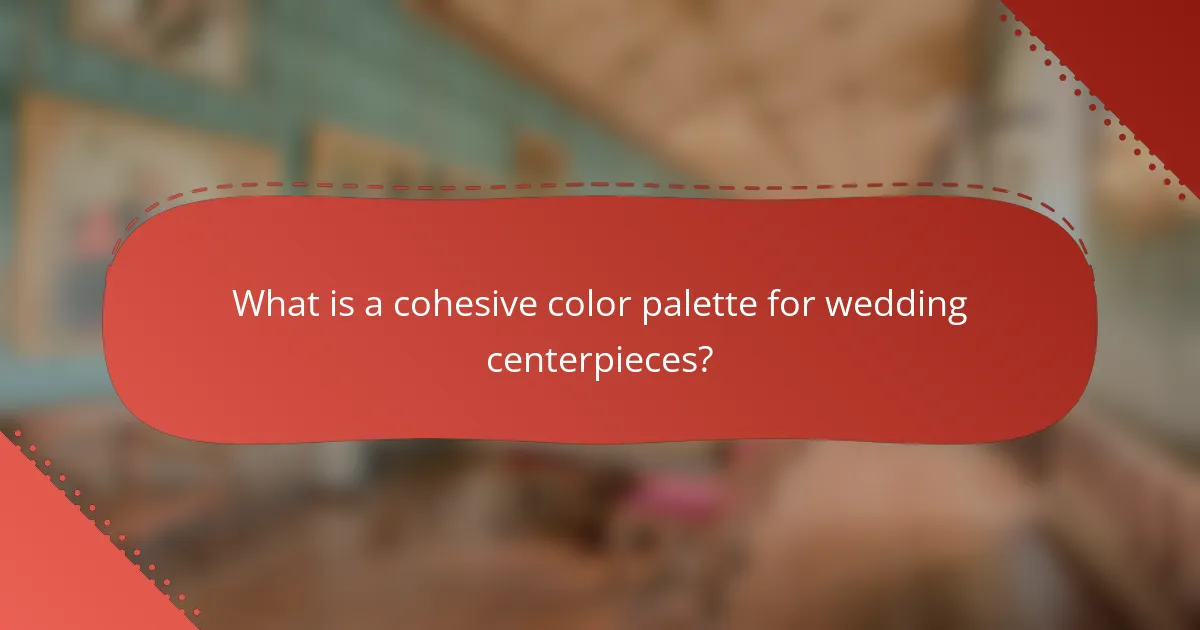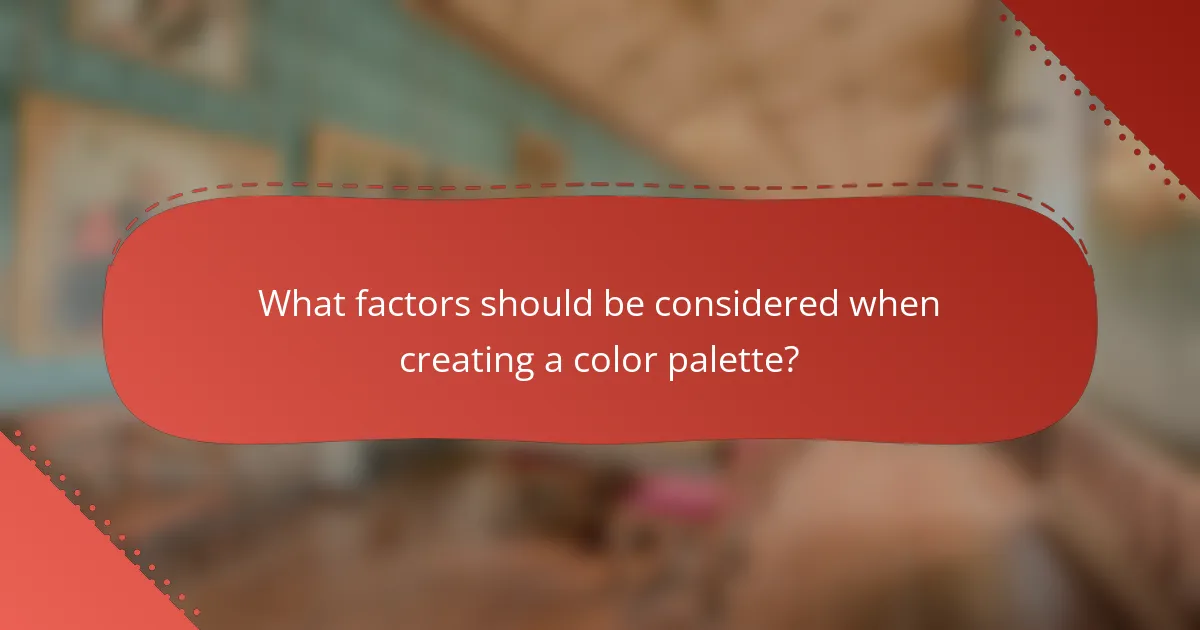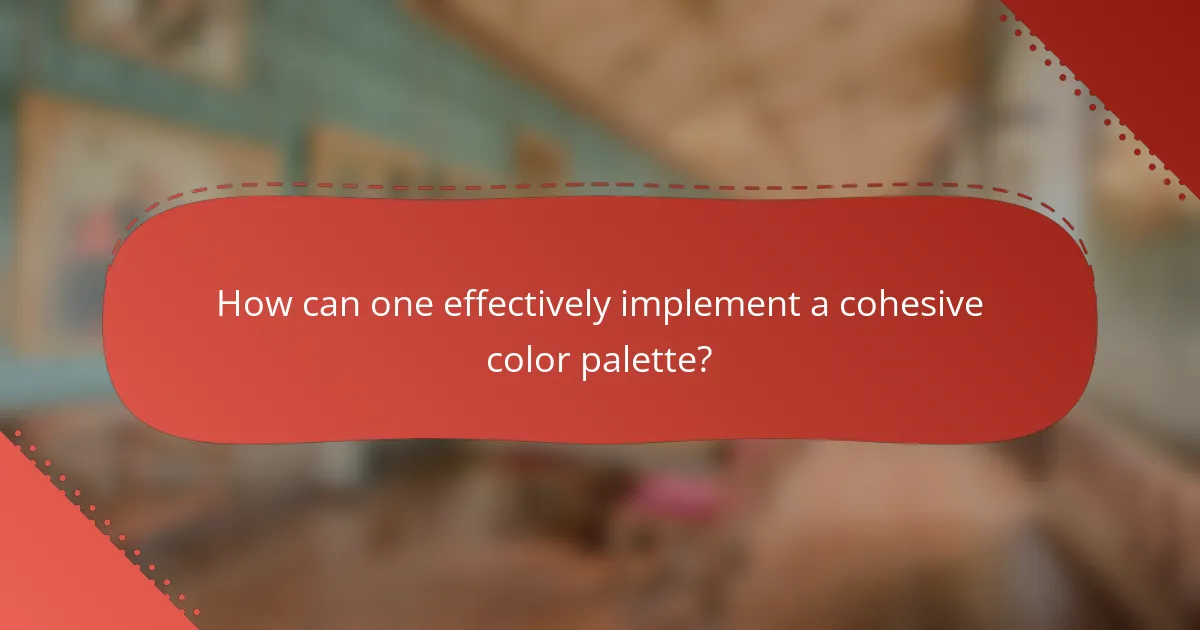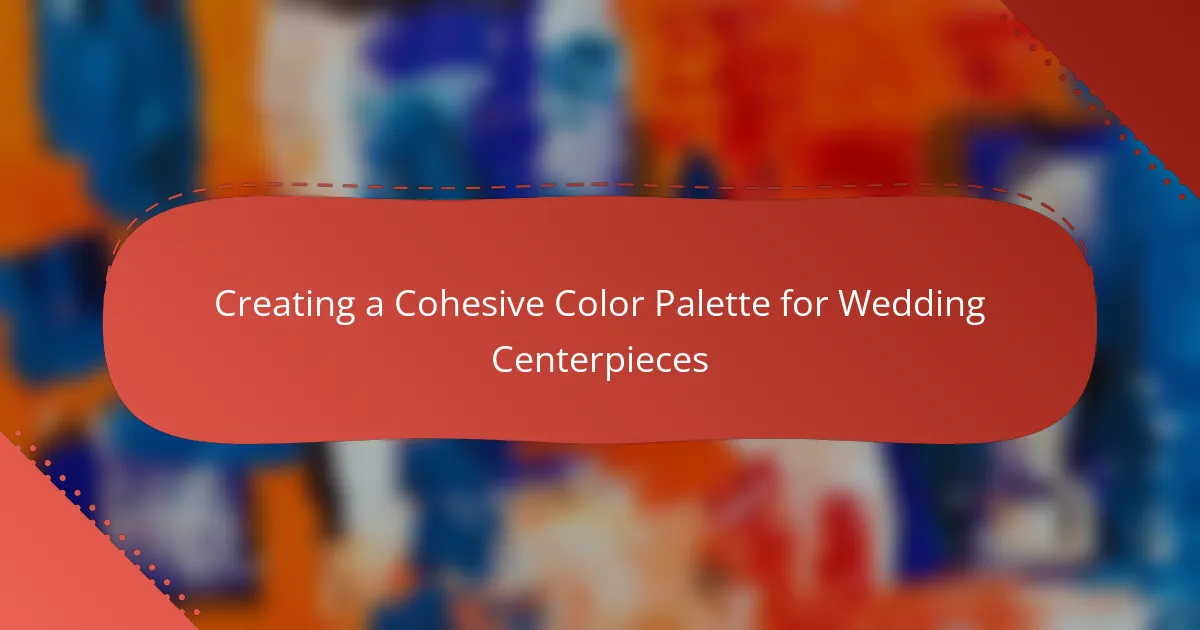
What is a cohesive color palette for wedding centerpieces?
A cohesive color palette for wedding centerpieces typically includes three to five complementary colors. This palette should harmonize with the overall wedding theme and venue decor. Common combinations include soft pastels, bold jewel tones, or a mix of neutrals with vibrant accents. For example, pairing blush pink with gold and white creates an elegant look. Research shows that color harmony enhances the visual appeal of event decor. According to color theory, complementary colors are opposite each other on the color wheel and create balance. Using a cohesive palette ensures that centerpieces enhance the overall aesthetic of the wedding.
How does a cohesive color palette enhance wedding centerpieces?
A cohesive color palette enhances wedding centerpieces by creating visual harmony. This harmony draws attention to the centerpieces, making them a focal point. When colors complement each other, they evoke emotions and set a mood. A well-chosen palette can unify various elements of the wedding decor. Studies show that color influences perception and can enhance overall aesthetic appeal. For instance, research from the Color Marketing Group indicates that color combinations can increase guest satisfaction. Thus, a cohesive palette not only beautifies but also enriches the wedding experience.
What are the key elements of a cohesive color palette?
A cohesive color palette consists of harmony, balance, and contrast. Harmony ensures colors work well together, creating a unified look. Balance involves using colors in proportion to avoid overwhelming the design. Contrast highlights key elements, making them stand out. Additionally, a cohesive palette often includes a dominant color, supporting colors, and accent colors. This structure guides the overall aesthetic. Research indicates that color theory supports these principles, enhancing visual appeal in design contexts.
How do colors interact to create harmony?
Colors interact to create harmony through complementary, analogous, and triadic relationships. Complementary colors are opposite each other on the color wheel. They enhance each other’s vibrancy when paired. Analogous colors sit next to each other on the wheel. They create a serene and comfortable design. Triadic colors are evenly spaced around the wheel. This combination offers a vibrant and balanced look. Harmony in color can evoke specific emotions and set the mood. For example, blue and orange create energy, while green and yellow promote calmness. Understanding these interactions helps in designing cohesive color palettes, especially for wedding centerpieces.
Why is selecting the right colors important for wedding centerpieces?
Selecting the right colors for wedding centerpieces is crucial for creating a cohesive aesthetic. The chosen colors influence the overall ambiance of the event. They can evoke specific emotions and set the tone for the celebration. For instance, soft pastels create a romantic vibe, while bold hues can energize the atmosphere. Additionally, color selection ensures that centerpieces complement the wedding theme and venue decor. This alignment enhances visual harmony throughout the space. Research shows that color can affect mood and perception, making it an essential element in event design. Therefore, thoughtful color choices can significantly enhance the guest experience and the overall success of the wedding.
What psychological effects do colors have on guests?
Colors significantly influence the psychological state of guests. Different colors evoke specific emotions and reactions. For instance, red can stimulate energy and excitement. Blue often promotes calmness and trust. Green is associated with tranquility and nature. Yellow tends to evoke happiness and warmth. Studies show that color can affect mood and behavior in social settings. Research by the Institute for Color Research indicates that people make subconscious judgments about environments within 90 seconds, primarily based on color. This highlights the importance of color choices in creating an inviting atmosphere for guests.
How can color choices reflect the wedding theme?
Color choices can effectively reflect the wedding theme by aligning with the overall aesthetic and mood desired. For instance, soft pastels may evoke a romantic garden theme, while bold colors can represent a modern or vibrant celebration. The selected colors can be used in floral arrangements, table settings, and decorations to create harmony. Research shows that color psychology influences emotions, meaning specific hues can enhance the wedding atmosphere. For example, blue often symbolizes tranquility, while red signifies passion. Therefore, a cohesive color palette can reinforce the theme and enhance the guests’ experience.

What factors should be considered when creating a color palette?
When creating a color palette, consider the overall theme and mood of the event. The chosen colors should reflect the desired atmosphere, such as romantic or vibrant. Next, analyze the color wheel to select complementary colors that enhance each other. It is essential to understand color psychology, as different colors evoke specific emotions. Additionally, consider the season and venue, as these factors influence color perception. Test the colors in various lighting conditions to ensure they appear as intended. Finally, limit the palette to three to five main colors for cohesiveness. These considerations ensure a visually appealing and harmonious color palette for wedding centerpieces.
How do seasonal colors influence palette selection?
Seasonal colors significantly influence palette selection by dictating the hues that resonate with specific times of the year. For instance, spring often features pastels like soft pinks and greens, while autumn is characterized by warm tones such as oranges and deep reds. These seasonal colors evoke certain emotions and atmospheres, aligning with the natural changes in the environment. Research shows that color psychology plays a role in how people perceive seasons, impacting choices in design and decor. A study by the Color Marketing Group indicates that color trends are often cyclical, reflecting seasonal shifts. Thus, selecting a color palette that aligns with seasonal colors enhances the overall aesthetic and emotional connection of wedding centerpieces.
What colors are popular in different wedding seasons?
Spring weddings often feature pastel colors. Soft pinks, light blues, and lavender are common choices. These colors reflect the blooming flowers of the season. Summer weddings tend to embrace vibrant hues. Bright yellows, coral, and turquoise are popular during this time. These colors capture the energy and warmth of summer. Fall weddings frequently incorporate rich, earthy tones. Deep oranges, burgundy, and mustard yellow are favored as leaves change color. Winter weddings typically showcase cool and elegant shades. Icy blues, silver, and deep greens are often chosen to reflect the season’s chill. Each season’s colors are influenced by nature and cultural trends.
How can seasonal elements be incorporated into the palette?
Seasonal elements can be incorporated into the palette by selecting colors that reflect the specific season. For spring, use pastels like soft pinks and greens. Summer palettes can feature vibrant hues such as bright yellows and blues. Autumn colors often include deep oranges, browns, and burgundies. Winter can be represented with cool tones like icy blues and whites, or rich jewel tones. Additionally, incorporating seasonal flowers and foliage can enhance the color scheme. For instance, tulips are ideal for spring, while dahlias can be used in summer arrangements. This approach ensures that the palette feels timely and relevant to the wedding’s season.
What role does the venue play in color palette selection?
The venue significantly influences color palette selection for wedding centerpieces. Its architectural style and decor set the overall ambiance. For instance, a rustic barn may inspire earthy tones. In contrast, a modern hotel could lead to sleek, vibrant colors. The venue’s lighting also affects color perception. Natural light can enhance softer hues, while dim lighting may require bolder choices. Additionally, the venue’s existing color scheme should be considered to ensure harmony. This approach creates a cohesive look that complements the space. Hence, the venue plays a crucial role in guiding the color palette for centerpieces.
How can venue decor influence color choices?
Venue decor significantly influences color choices by setting the overall aesthetic tone of the space. The existing color scheme of a venue can dictate complementary or contrasting color selections for centerpieces. For instance, a venue with warm wooden tones may inspire the use of earthy or muted colors. Conversely, a modern venue with sleek, neutral colors might encourage vibrant or bold color choices to create visual interest.
Additionally, decor elements such as table linens, wall colors, and floral arrangements can all impact color decisions. Research shows that color psychology affects mood and perception, which can further guide color selection. Therefore, understanding the decor’s influence is crucial for creating a cohesive and visually appealing color palette for wedding centerpieces.
What are some tips for matching colors to venue aesthetics?
To match colors to venue aesthetics, start by assessing the venue’s existing color scheme. Identify dominant colors in the decor, walls, and furnishings. Use a color wheel to find complementary colors that enhance these tones. Consider the mood you want to create; warm colors can evoke intimacy, while cool colors promote calmness. Test color swatches in the venue’s lighting to see how they appear. Pay attention to seasonal influences that may affect color choices. Finally, ensure that the selected colors align with the overall theme of the wedding. These strategies help create a harmonious atmosphere that resonates with the venue’s aesthetics.

How can one effectively implement a cohesive color palette?
To effectively implement a cohesive color palette, start by selecting a primary color that reflects the theme. This primary color will serve as the foundation for your palette. Next, choose two to three complementary colors that enhance the primary color. These should be harmonizing shades that create visual interest without clashing.
Utilize color theory principles, such as analogous or triadic schemes, to guide your selections. Test the palette by creating mock-ups of centerpieces. This allows for adjustments before finalizing the design. Consistency is key; use the chosen colors across all elements, including flowers, linens, and tableware.
Research indicates that a well-defined color palette can enhance the overall aesthetic of wedding decor. According to a study by the Color Marketing Group, cohesive color schemes positively impact guests’ perceptions of an event.
What are the best practices for combining colors in centerpieces?
The best practices for combining colors in centerpieces include using a color wheel for guidance. Complementary colors, which are opposite each other on the wheel, create vibrant contrasts. Analogous colors, located next to each other, offer a harmonious look. Limit the palette to three main colors for balance. Incorporate different shades and tints of these colors for depth. Consider the season and venue to enhance the overall theme. Textures and materials can also influence color perception. Research shows that cohesive color palettes improve visual appeal in event design.
How can contrasting colors be used effectively?
Contrasting colors can be used effectively to create visual interest and highlight specific elements in wedding centerpieces. By pairing complementary colors, such as blue and orange or purple and yellow, designers can draw attention to focal points. This technique enhances the overall aesthetic and adds depth to the arrangement. Studies show that contrasting colors can evoke emotional responses, making them powerful for event decor. For example, a vibrant red against a soft white can create a striking effect, making the centerpiece stand out. Utilizing contrasting colors also helps to balance the visual weight of the arrangement. This method encourages the eye to move across the centerpiece, creating a dynamic visual experience.
What techniques can enhance color coordination in arrangements?
Utilizing the color wheel enhances color coordination in arrangements. Complementary colors create vibrant contrasts. Analogous colors provide harmony through adjacent color choices. Monochromatic schemes use varying shades of a single color for depth. Neutrals can balance bold colors, offering visual relief. Textures and patterns can also enrich color coordination. Seasonal palettes align colors with specific times of year, enhancing relevance. Research indicates that color psychology influences emotional responses, impacting overall aesthetics.
What common mistakes should be avoided when choosing colors?
Common mistakes to avoid when choosing colors include selecting too many colors, which can create visual chaos. Sticking to a limited palette of three to five colors ensures harmony. Ignoring the venue’s lighting can lead to unexpected color outcomes. Testing colors in the actual space allows for better decision-making. Overlooking seasonal color trends may result in a palette that feels outdated. Researching current trends can keep the design fresh. Finally, failing to consider the emotional impact of colors can lead to unintended feelings. Understanding color psychology helps convey the desired mood.
How can overusing colors disrupt the visual appeal?
Overusing colors can disrupt visual appeal by creating a chaotic look. When too many colors are present, it becomes difficult for the eye to focus. This can lead to visual confusion and overwhelm the viewer. In design, a balanced color palette enhances harmony and coherence. Research shows that colors evoke emotions and can influence perceptions. A cluttered color scheme may detract from the intended mood. Consistency in color usage is key to effective design. Therefore, limiting color choices helps maintain visual clarity and attractiveness.
What are the pitfalls of neglecting color balance?
Neglecting color balance can lead to overwhelming visual clutter. This occurs when colors clash or compete for attention. As a result, the centerpiece may fail to create a harmonious atmosphere. Poor color balance can also distract from the overall theme of the wedding. It may confuse guests about the intended mood or message. Additionally, imbalanced colors can reduce the perceived elegance of the decor. This can negatively impact photographs taken during the event. Studies show that color harmony enhances emotional responses, making balanced palettes crucial for memorable experiences.
What practical tips can help in creating a cohesive color palette for wedding centerpieces?
Select a color scheme that complements the wedding theme. Use a color wheel to identify harmonious colors. Limit the palette to three to five main colors for simplicity. Incorporate varying shades and tones of the chosen colors for depth. Consider the venue’s colors and existing decor to ensure cohesion. Use natural elements like flowers and greenery to enhance the palette. Test the colors together in fabric swatches or digital mock-ups. Gather feedback from trusted sources to refine the choices.
Creating a cohesive color palette for wedding centerpieces involves selecting three to five complementary colors that harmonize with the wedding theme and venue decor. This article examines how a well-chosen color palette enhances visual appeal, evokes emotions, and creates a unified aesthetic. Key elements include understanding color interactions, the psychological effects of colors on guests, and the influence of seasonal and venue-specific factors. Practical tips for avoiding common mistakes and ensuring effective color coordination will also be discussed, providing a comprehensive guide for achieving a visually appealing centerpiece arrangement.
